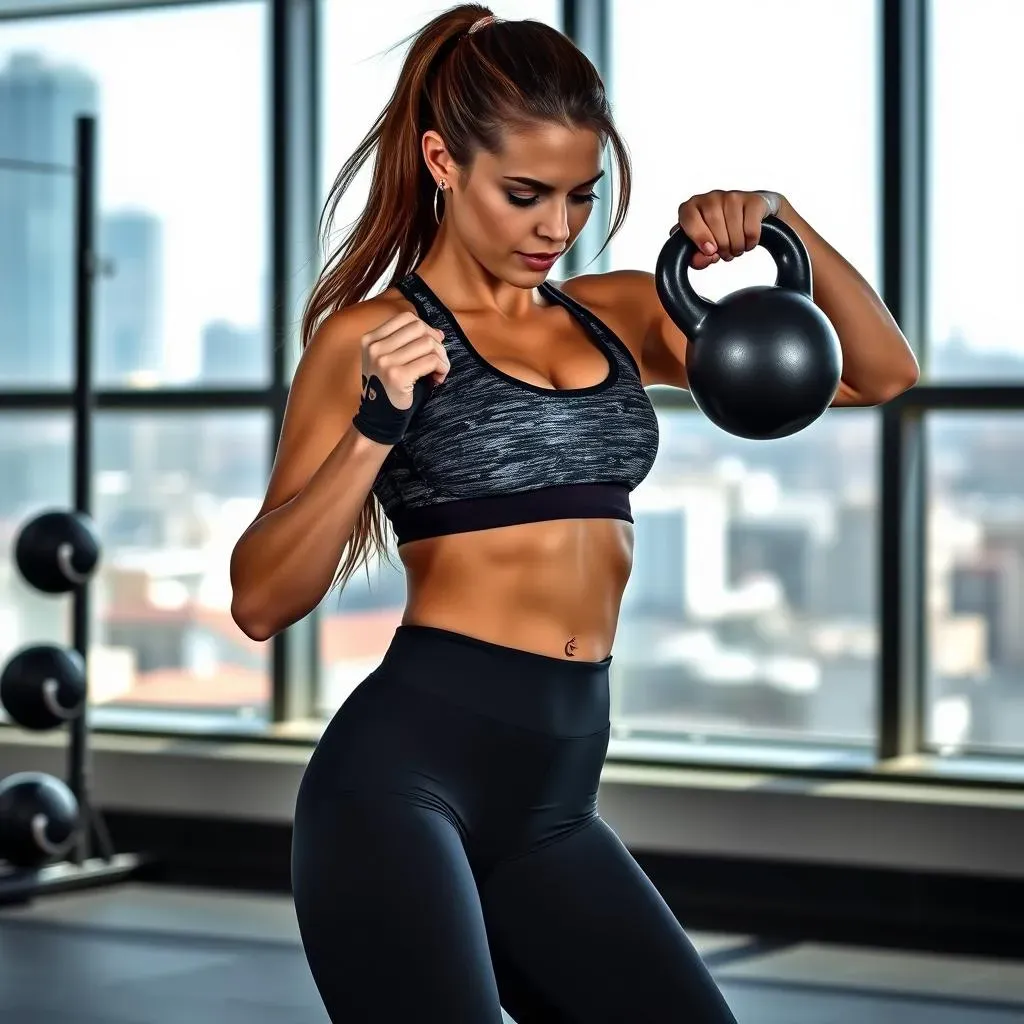Table of Contents
Ready to unlock your fitness potential without fancy gym equipment? Then grab a kettlebell – you're about to discover the power of simple, effective exercises. This article reveals the 5 best kettlebell exercises for beginners, transforming your workouts from boring to exhilarating. We'll walk you through each exercise step-by-step, ensuring you master the proper form for optimal results and injury prevention. Forget complicated routines; we’re focusing on foundational movements that build serious strength and endurance. Whether you're a complete newbie or looking to add some spice to your existing routine, get ready to sculpt your body, boost your metabolism, and unleash your inner strength. We'll explore the benefits of each exercise, showing you exactly how these 5 movements can help you achieve your fitness goals. So, let's dive into the world of kettlebell training and discover why these exercises are considered some of the best for building a strong, healthy body. This is your guide to mastering the "5 best kettlebell exercises" and reaching your fitness peak.
Kettlebell Swings: The King of Exercises

Kettlebell Swings: The King of Exercises
Mastering the Kettlebell Swing
Hey, so you're diving into kettlebell swings? Awesome choice! They're seriously the cornerstone of a killer kettlebell workout. Think of them as the ultimate full-body exercise – you're hitting your legs, glutes, core, and even your back, all at once. It's like a dynamic dance between power and control. Start with a lighter weight to get the hang of the movement; you don't want to hurt yourself right away. Focus on that hinge at your hips – imagine you're trying to slam a door shut with your backside. Keep your core tight, your back straight, and let the momentum do the work. Don't just fling the kettlebell around like a crazy person. It's all about smooth, controlled power. You’ll feel it working your muscles in a way that other exercises just don't.
Once you’ve got the basic swing down, you can start to play around with different variations. Want to challenge yourself? Try the Russian Kettlebell Swing, focusing on explosive power. Or, for a more controlled movement, try the American Kettlebell Swing, emphasizing a higher arc and more shoulder engagement. Remember to listen to your body; don't push yourself too hard, especially when you’re starting out. A good beginner kettlebell program can help guide you. Check out our beginner kettlebell program for more tips!
Swing Type | Focus | Intensity |
|---|---|---|
American Kettlebell Swing | Higher arc, shoulder engagement | Moderate |
Russian Kettlebell Swing | Explosive power | High |
Common Mistakes to Avoid
One common mistake beginners make is rounding their back during the swing. This is a recipe for back pain! Keep your core engaged and your spine neutral throughout the movement. Another frequent error is using too much arm power. The swing should be driven by your hips and legs; your arms just act as guides. Think of it like a pendulum – the weight should swing naturally, not because you're forcing it. Finally, don’t rush it! Proper form is key, and that takes time and practice. It's better to do fewer reps with perfect form than many reps with poor form, leading to injury. Want a quick guide? This basic kettlebell exercises PDF is a good place to start.
Remember, consistency is key! Even a short, focused kettlebell workout a few times a week is better than sporadic, intense sessions. Start with a routine that fits your schedule and fitness level. Don't be afraid to experiment with different variations and find what works best for you. And most importantly, have fun! Kettlebell training should be enjoyable, and the results will come naturally. If you're looking for a full body workout, check out our full body kettlebell workout for beginners.
- Maintain a straight back.
- Use your hips, not your arms.
- Focus on controlled movements.
Kettlebell Goblet Squats: A Powerful LowerBody Builder

Kettlebell Goblet Squats: A Powerful LowerBody Builder
Getting Started with Goblet Squats
Alright, let's talk goblet squats! These are fantastic for building serious lower-body strength. Hold a kettlebell vertically against your chest, like you're holding a big, heavy goblet. Now, squat down as if you're sitting in a chair, keeping your back straight and your chest up. Focus on pushing through your heels as you stand back up. It's a simple movement, but it's incredibly effective. You'll feel it working your quads, glutes, and hamstrings – the whole shebang! Start with a weight you can comfortably manage for 10-12 repetitions. Remember, proper form is crucial; don't sacrifice it for more weight.
Don't underestimate the goblet squat! It's a fundamental exercise that builds a solid foundation for more advanced movements. It's perfect for beginners because it's relatively easy to learn and master, and it's a great way to get comfortable with the weight. Plus, you'll build strength and power in your legs and core. Need a more comprehensive beginner's program? Check out our beginner kettlebell program for a structured approach.
- Hold kettlebell close to your chest.
- Squat down, keeping your back straight.
- Push through your heels to stand up.
Variations and Progressions
Once you've mastered the basic goblet squat, you can start to add variations to make it more challenging. Try pausing at the bottom of the squat for a second or two to increase the time under tension. You can also add a jump at the top of the movement for an explosive plyometric variation. Or, if you're feeling really ambitious, try using two kettlebells for a double goblet squat. But remember, always prioritize proper form over increasing the weight or adding variations too quickly. A solid foundation is key to avoiding injury.
To really maximize your results, incorporate goblet squats into a well-rounded workout routine. They work amazingly well as part of a full-body strength training program. They're also great for improving your overall mobility and balance. Remember, consistency is key, so aim for regular workouts. Even a short, focused session a few times a week can make a big difference. Need some ideas? Check out our kettlebell workouts for beginners for a variety of routines.
Variation | Description | Intensity |
|---|---|---|
Pause Squat | Pause at the bottom of the squat | Medium |
Jump Squat | Add a jump at the top | High |
Double Goblet Squat | Use two kettlebells | High |
Common Mistakes and How to Fix Them
A common mistake is leaning too far forward during the squat. This puts extra stress on your lower back. Focus on keeping your chest up and your weight in your heels. Another frequent error is not going deep enough into the squat. Aim to get your thighs parallel to the ground, or even lower if you're flexible enough. Finally, don't forget to breathe! Inhale as you lower down and exhale as you stand back up. This helps to control the movement and prevents you from getting lightheaded.
Remember, listen to your body. If you feel any pain, stop immediately. Proper form is essential to prevent injuries and maximize the benefits of the exercise. Start slowly, gradually increasing the weight and repetitions as you get stronger. And don't be afraid to ask for help! If you're unsure about your form, consult a qualified fitness professional. They can guide you through the proper techniques and help you avoid common pitfalls. For a quick reference, you can check out our basic kettlebell exercises PDF.
- Keep your chest up.
- Go deep enough into the squat.
- Breathe properly.
Kettlebell Rows: Strengthening Your Back

Kettlebell Rows: Strengthening Your Back
Getting Started with Kettlebell Rows
Kettlebell rows? Yeah, these are a game-changer for building a strong, powerful back. Forget those wimpy bicep curls; this exercise targets your entire back, from your traps to your lats. You'll feel the burn, trust me! Start by holding a kettlebell in one hand, letting it hang down naturally. Hinge at your hips (like you're doing a kettlebell swing but without the swing!), keeping your back straight. Pull the kettlebell up towards your chest, squeezing your shoulder blades together. Slowly lower it back down. It's all about controlled movement. Start with a weight that lets you maintain good form for 8-10 repetitions on each side. Don't go too heavy, especially at first!
Focus on that controlled movement, really feeling the muscles in your back working. Don’t just yank the weight up; engage your back muscles and pull with purpose. A common mistake is using momentum, so make sure you're pulling with your back, not your arms. This is a fantastic exercise for building strength and improving posture. Remember, consistency is key. Even a few sets a couple of times a week can make a huge difference. Want a structured program? Check out our beginner kettlebell program!
- Maintain a flat back.
- Pull with your back muscles.
- Controlled movement is key.
Variations to Amp Up Your Workout
Once you're comfortable with the basic kettlebell row, it's time to mix things up! Try different grips – a neutral grip (palms facing each other) can be easier on your wrists, while a pronated grip (palms down) can target different muscle fibers. You can also experiment with different stances – a staggered stance can help with balance and stability. Or, try doing one-arm rows, alternating sides. This will challenge your core and balance even more. And as always, remember to gradually increase the weight as you get stronger. Don't try to lift more than you can handle safely.
Incorporate kettlebell rows into a well-rounded workout routine. They pair perfectly with other back exercises, and they're a great way to build a strong and balanced physique. Don't forget to work your other muscle groups as well – a balanced approach to fitness is always best. For more kettlebell workout ideas, check out our beginner kettlebell workouts.
Variation | Description | Focus |
|---|---|---|
Neutral Grip Row | Palms facing each other | Wrist comfort |
Pronated Grip Row | Palms facing down | Different muscle fibers |
Staggered Stance Row | One foot slightly ahead | Balance and stability |
Common Mistakes and How to Avoid Them
A common mistake is arching your back during the row. This puts unnecessary stress on your spine and can lead to injury. Keep your core tight and your back straight throughout the movement. Another frequent error is using momentum instead of controlled power. Focus on squeezing your shoulder blades together as you pull the kettlebell up. Finally, don't forget to breathe! Inhale as you lower the kettlebell and exhale as you pull it up. This will help to control the movement and prevent you from getting lightheaded.
Remember, safety first! If you're ever unsure about your form, consult a qualified fitness professional. They can help you develop proper technique and prevent injuries. Start slowly, gradually increasing the weight as you get stronger. Listen to your body – if you feel any pain, stop immediately. And most importantly, have fun! Kettlebell training should be enjoyable, and the results will come with time and consistency. Check out our basic kettlebell exercises PDF for a quick reference guide.
- Keep your back straight.
- Use controlled power.
- Breathe properly.
Kettlebell Turkish GetUps: The FullBody Challenge

Kettlebell Turkish GetUps: The FullBody Challenge
Getting Started with Turkish Get-Ups
Okay, buckle up, because the Turkish Get-Up is where things get *really* interesting. This isn't just an exercise; it's a full-body movement that's like a complex puzzle of strength, balance, and coordination. You'll start by lying on your back with a kettlebell in one hand. The goal? To get to a standing position, then back down again, all without dropping the weight. It sounds harder than it is, but trust me, it’s a challenge at first! Start with a lighter weight – you're not trying to show off here; you're building control and strength. Focus on each individual step, ensuring a smooth, controlled transition between positions. There are a lot of steps involved, so don't rush it. Take your time and focus on proper form.
This exercise is seriously amazing for improving your overall body control and stability. It's also a great way to build core strength and improve your shoulder mobility. It's a fantastic exercise for improving your overall fitness level and coordination. Need a structured plan to help you learn the get up? Our beginner kettlebell program includes a detailed guide.
- Lie on your back with a kettlebell.
- Slowly transition to a standing position.
- Reverse the process to return to lying down.
Breaking Down the Movement: Steps to Success
Let's break down the Turkish Get-Up into manageable steps. First, you'll lie on your back with the kettlebell held in one hand, extended straight up. Then, you'll roll onto your side, pressing yourself up to a forearm position. Next, you'll bring your other leg under you, pushing yourself up to a kneeling position. From there, you'll stand up, holding the kettlebell steadily in your hand. The return movement is the reverse of these steps. This is a whole-body exercise that improves your posture and balance! It's a fantastic way to improve your overall fitness. For more exercises that are sure to help you, check out our beginner kettlebell workouts.
Remember, the Turkish Get-Up is a challenging exercise, but it's also incredibly rewarding. Don't get discouraged if you don't master it right away. It takes time and practice, but with patience and persistence, you'll get there. Focus on mastering each step before moving on to the next. Start with a light weight and gradually increase it as you become more comfortable with the movement. And most importantly, have fun! This exercise can be a fun challenge when you really get the hang of it. If you're looking for a full-body workout, check out our full body kettlebell workout for beginners.
Step | Description | Key Focus |
|---|---|---|
1 | Lie on your back | Stable base |
2 | Roll to your side | Controlled movement |
3 | Kneel | Balance and core strength |
4 | Stand | Full body coordination |